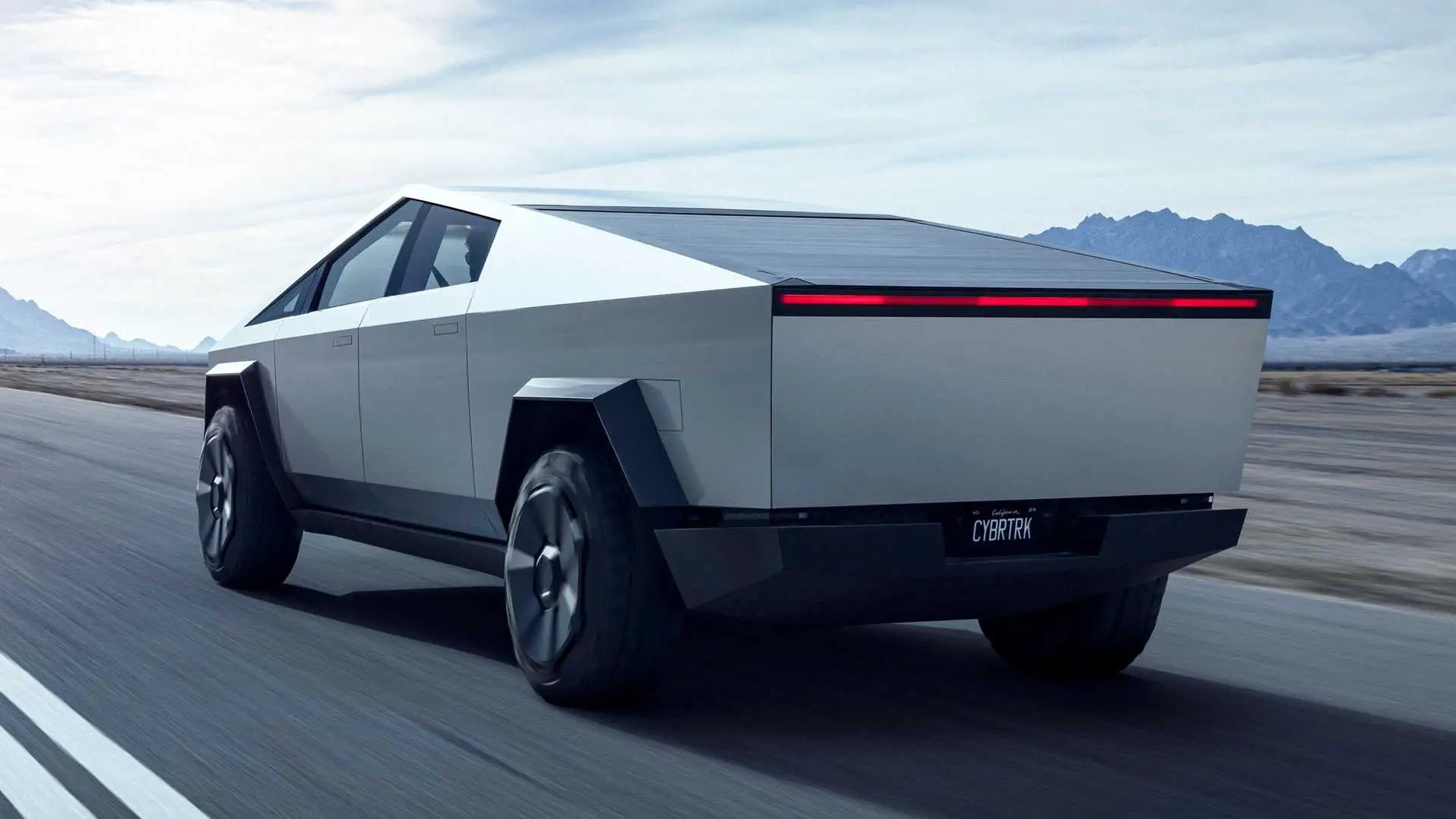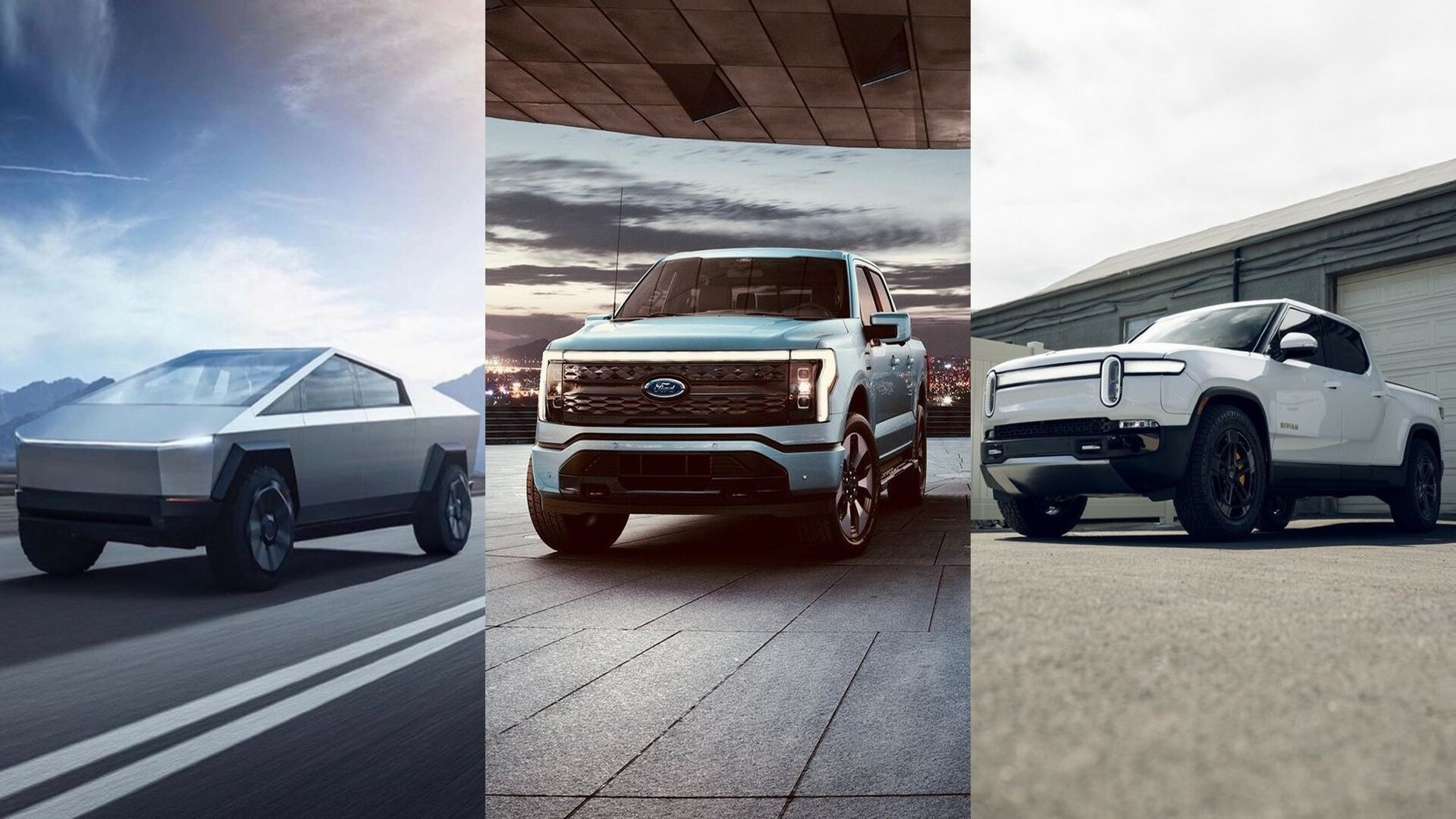The 2024 Tesla Cybertruck has made its way to the first buyers, boasting up to 845 horsepower, an estimated range of up to 470 miles, and a starting price slightly above $81K.
In contrast, the Ford F-150 Lightning begins at $52,090, with its mightiest model featuring 580 horsepower and the longest-range variant offering a 320-mile estimate.
The Rivian R1T kicks off at $74,800, with higher-end models equipped with four motors delivering 835 horsepower and a maximum estimated range of 410 miles.
While all three are electric pickup trucks, their commonalities extend beyond their powertrains. They represent the current selection of EV pickups available to consumers, with the GMC Hummer EV SUT being the fourth contender.
However, for this comparison, we’ll focus on the Cybertruck, F-150 Lightning, and R1T, which are more accessible options compared to the behemoth Hummer.
Ford and Rivian have been in the market for some time now, with various versions tested. On the other hand, Tesla’s polarizing pickup recently reached its initial customers, coinciding with the release of updated specifications encompassing power output, range estimates, and pricing.
Let’s delve into how the Cybertruck measures up against the F-150 Lightning and the R1T.
Comparing Their Powertrains
Similar to its rivals, the Cybertruck offers multiple powertrain configurations. The entry-level option will be a single-motor rear-wheel-drive setup, although specifics are scarce, and it won’t be accessible until the following year.
Until then, every Cybertruck will come with all-wheel drive and either two or three electric motors. The two-motor setup delivers 600 horsepower, while the three-motor setup, known as Cyberbeast, yields an impressive 845 horses; Tesla has not disclosed torque figures.
Contrasting with the Cybertruck, the F-150 Lightning features standard all-wheel drive and dual electric motors, generating either 452 or 580 horsepower (depending on battery size) and 775 pound-feet of torque.
Meanwhile, the Rivian R1T stands out as the sole model available with four electric motors, offering 835 horsepower and 908 pound-feet of torque.
Additionally, a dual-motor all-wheel-drive configuration is available in two outputs: the standard version delivers 553 horsepower and 610 pound-feet, while the Performance model elevates those figures to 665 horsepower and 829 pound-feet.

Comparing Their Range And Charge Times
Although the Ford and Rivian have EPA range estimates, Tesla’s claims are yet to be certified. However, the company estimates that the Cybertruck will offer between 250 and around 470 miles of range.
The lower range applies to the RWD model, while the AWD model claims 340 miles and the Cyberbeast model claims 320 miles. With the optional range extender (an additional battery pack mounted in the cargo bed), these estimates increase to 440 and 470 miles for Cybertrucks.
While the Rivian R1T cannot match the Cybertruck’s maximum range claim, it’s not far behind. The R1T’s peak 410-mile EPA estimate applies to dual-motor models with the largest available battery, and no space in the bed needs to be sacrificed to achieve this range.
The lowest rating for the R1T is 270 miles, while the Performance model’s minimum is 352 miles. All quad-motor setups have a 328-mile estimate. Conversely, the electric F-150 offers three different range estimates and two battery options.
The standard setup provides a rating of 240 miles, but selecting the extended-range battery increases the peak to 320 miles. The Platinum model exclusively features the larger battery, but its estimate drops to 300 miles due to its massive 22-inch wheels.
The Cybertruck holds the exclusive advantage of access to Tesla’s extensive Supercharger network—for the time being. However, Ford and Rivian have both committed to adopting Tesla’s proprietary NACS charge port by 2025.
But how do these three currently fare when connected to a DC fast-charger? Tesla asserts that the Cybertruck boasts a peak charging rate of 250 kilowatts, capable of adding up to 136 miles in just 15 minutes.
Ford claims that with a 150-kW connection, the Lightning requires 10 minutes to add between 41 and 54 miles, contingent on battery size, with a 15-to-80 percent charge estimated to take 41–44 minutes.
Rivian asserts that the R1T has a peak charging rate exceeding 200 kilowatts (with an upcoming over-the-air update expected to increase speeds to over 300 kW). At present, the R1T purportedly adds up to 140 miles of range in just 20 minutes.
Comparing Their Sizes & Weights
Measuring 223.7 inches from end to end, the Tesla Cybertruck surpasses the Rivian R1T by 6.6 inches in length and falls short of the F-150 Lightning by nine inches. Standing at 70.5 inches tall, the Cybertruck is 2.5 inches lower than the R1T and 8.3 inches shorter than the Lightning.
While Tesla does not provide the Cybertruck’s width without mirrors, it spans 86.6 inches wide with them folded. Comparatively, with mirrors folded, the Lightning measures 83.3 inches wide, and the R1T extends to 81.8 inches wide.

Tesla states that the AWD Cybertruck weighs 6603 pounds, while the Cyberbeast version, with an additional electric motor, tips the scales at 6843 pounds.
However, these claims cannot be verified, and neither likely includes the optional range-extender battery, which could weigh over 1000 pounds.
In comparison, the tested F-150 Lightning Platinum and Rivian R1T Quad-Motor have curb weights of 6855 and 7173 pounds, respectively.
For a clearer understanding of the weight of these EV trucks, we looked into Cybertruck’s gross vehicle weight rating (GVWR), ranging from 8001 to 10,000 pounds. Similarly, the R1T has an 8532-pound GVWR, while the Lightning’s GVWR falls between 8250 and 8550 pounds.
Comparing The Towing & Hauling Capabilities
Regarding towing capacity, both the Cybertruck and Rivian R1T boast an impressive 11,000-pound max towing capacity, whereas the F-150 Lightning can haul up to 10,000 pounds.
However, this drops to 7700 pounds on models with the standard-range battery. The RWD Cybertruck’s tow capacity is capped at 7500 pounds.
In terms of payload, the Cybertruck leads the pack, with all configurations capable of hauling up to 2500 pounds, surpassing the Lightning’s 2235 pounds and the R1T’s 1764 pounds. Notably, Ford’s larger battery reduces its payload rating to 1952 pounds.
Each electric pickup offers a single-size cargo bed, with the Cybertruck measuring six feet long and four feet wide. However, the buttresses extending down the sides may hinder access from certain angles.
Both the Lightning and R1T feature tonneau covers, with Ford’s box measuring 5.6 feet long and 4.2 feet wide, and the Rivian’s bed slightly smaller at 4.5 feet long and 4.3 feet wide.
While all three pickups have a front trunk, only the Rivian features an innovative gear tunnel that extends horizontally between its rear doors and the truck bed.
Comparing Their Prices
In terms of pricing, the Ford F-150 Lightning stands as the most affordable option. The 2024 Lightning starts at $52,090 for the Pro trim and goes up to $92,090 for the Platinum trim with the big battery.
On the other hand, Rivian has yet to release pricing for the 2024 R1T lineup, with expectations of a slight increase over outgoing models. The previous generation started at $74,800 for the AWD Adventure trim, with additional costs for battery upgrades.
The Dual-Motor Performance variant starts at $85,800, while the Quad-Motor R1T’s base price is $88,800. When the initial production versions of the Cybertruck were unveiled, Tesla advertised a base price of $60,990.
However, this price applies to the RWD model, slated for release sometime next year. For 2024, the AWD Cybertruck starts at $79,990, while the Cyberbeast begins at $99,990. These prices exclude the destination fee, which currently stands at $1390 for all other Teslas.
Including this fee, the 2024 Cybertruck models commence at just over $81K and $101K. These prices are expected to increase further with the optional range-extender battery, although Tesla has not yet released pricing for any options.

It’s essential to note that Ford, Rivian, and Tesla have a history of fluctuating prices, so it’s plausible that the Cybertruck, Lightning, and R1T may undergo price adjustments in the coming year.
While Ford and Rivian have increased production of their pickups, the availability of the Cybertruck remains uncertain. Despite delivering approximately a dozen Cybertrucks to customers, Tesla’s future production plans are unclear.
During an October earnings call, CEO Elon Musk acknowledged production challenges, expressing doubts about achieving the goal of manufacturing 250,000 Cybertrucks annually until 2025, as reported by the Associated Press.
While many uncertainties lie ahead, our focus remains on comparing the Cybertruck with the Ford F-150 Lightning and Rivian R1T. Ultimately, the decision on which pickup sounds the most compelling is left to you to decide.

